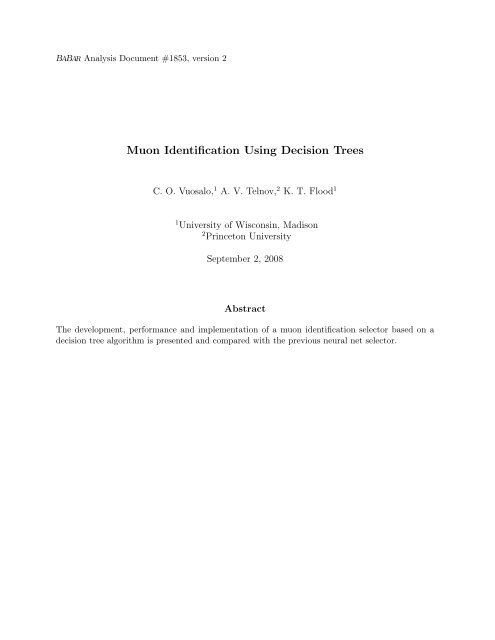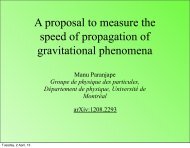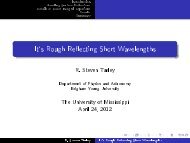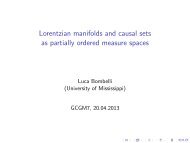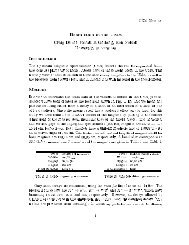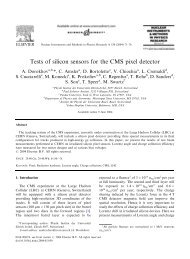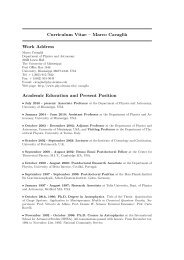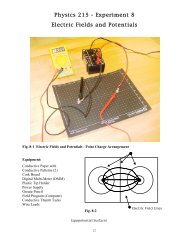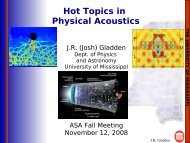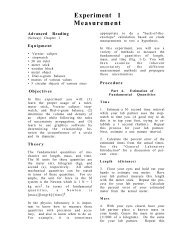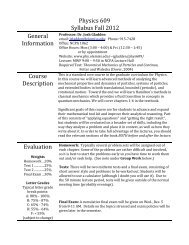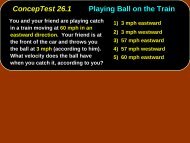Muon Identification Using Decision Trees
Muon Identification Using Decision Trees
Muon Identification Using Decision Trees
You also want an ePaper? Increase the reach of your titles
YUMPU automatically turns print PDFs into web optimized ePapers that Google loves.
BABAR Analysis Document #1853, version 2<br />
<strong>Muon</strong> <strong>Identification</strong> <strong>Using</strong> <strong>Decision</strong> <strong>Trees</strong><br />
C. O. Vuosalo, 1 A. V. Telnov, 2 K. T. Flood 1<br />
1 University of Wisconsin, Madison<br />
2 Princeton University<br />
September 2, 2008<br />
Abstract<br />
The development, performance and implementation of a muon identification selector based on a<br />
decision tree algorithm is presented and compared with the previous neural net selector.
Contents<br />
1 Introduction 3<br />
2 The <strong>Muon</strong> Detector (IFR) 3<br />
3 Variables for <strong>Muon</strong> <strong>Identification</strong> 4<br />
4 Bagger <strong>Decision</strong> <strong>Trees</strong> 5<br />
5 Control Samples 7<br />
6 Training and Validation 13<br />
7 <strong>Muon</strong> BDT Selectors in ROOT 14<br />
8 Performance of <strong>Muon</strong> BDT Selectors 15<br />
9 Implementation in BetaPid 19<br />
2
1 Introduction<br />
The momentum spectrum of muons from generic Υ (4S) → BB decays is shown in Fig. 1. Highperformance<br />
muon identification is important in many of the physics analyses at BABAR; its uses<br />
include B flavor tagging, B 0 − Bzb mixing, reconstruction of semileptonic decays of B and cascade<br />
D mesons, which are the primary source of muons at this center-of-mass energy, reconstruction of<br />
the J/ψ resonance in the J/ψ → µ + µ − channel, study of the b → sµ + µ − decays, etc.<br />
In this context, it is very important to have a good muon identification system in terms of<br />
the hardware (detector) and the software algorithm. A brief description of the muon detector is<br />
provided in the next section. Up to now, two types of muon identification algorithms were being<br />
used for the data analysis in BABAR, the Cut-based muon selector [1] and the Neural Network<br />
selector [5].<br />
This note reports on the development of a new muon selector based on a Bagger <strong>Decision</strong><br />
Tree (BDT) algorithm. Following a brief description of the IFR and the existing muon selectors,<br />
the functionality, performance and implementation of the new selector is presented. The selector<br />
performance is evaluated on standard µ and π PID control samples.<br />
momentum
elatively small polar angles; however, due to the boost of the Υ (4S) system at PEP-II, about 40%<br />
of the muons within the BABAR detector’s acceptance pass through the forward IFR endcap). There<br />
is a total of 65 cm (4 interaction lengths) of iron in the Barrel and 60 cm of iron in each End Cap.<br />
There is ∼ 1 interaction length of material before the first RPC layer.<br />
The original BABAR RPCs, installed in 1998, exhibited a rapid (∼ 10 − 15%/year) loss of singlelayer<br />
efficiency. To address this problem, during the summer of 2002 the thickness of the forward<br />
EC was increased to ∼ 6λ by the addition of non-magnetic absorber (brass), and 18 layers of the<br />
original forward RPCs were replaced with 16 layers of new, high-quality RPCs. In the summer<br />
2004, the top and bottom barrel IFR sectors were upgraded to 12 layers of Limited Streamer Tubes<br />
(LSTs); additional brass absorber was added in place of the other 6 RPC layers to firther enhance<br />
muon ID in the barrel. The LST upgrade of the entire IFR barrel was concluded in summer 2006,<br />
making BABAR Runs 6 and 7 the only to have fully benefited from the superior muon ID offered by<br />
the LST technology.<br />
Electrical signals in a RPC are collected capacitively by strip electrodes along orthogonal directions<br />
to obtain a two-dimensional readout for each active layer; in LSTs, the track’s ϕ coordinate is<br />
read off the wires that run the length of the barrel. The hit strips associated with a charged track<br />
are grouped into “3-D” clusters by extrapolating a track reconstructed in the Drift Chamber to<br />
the IFR. The intersections of the extrapolated track with the active layers are computed. Only hit<br />
strips which are less than a given distance from those intersections are associated to the charged<br />
cluster.<br />
3 Variables for <strong>Muon</strong> <strong>Identification</strong><br />
The quantities used for muon identification in the Cut-based Selector are [1]<br />
1. The energy released in the Electromagnetic Calorimeter (E cal )<br />
2. The number of IFR hit layers in the 3-D cluster (N L )<br />
3. The measured number of interaction lengths traversed by the track in the BABAR detector<br />
(λ meas ). It is estimated from the last layer hit by the extrapolated track in the IFR.<br />
4. Delta Lambda, ∆λ = λ exp −λ meas , where (λ exp ) is the number of interaction lengths expected<br />
to be traversed by the track in the muon hypothesis<br />
5. The χ 2 /d.o.f. of the IFR hit strips w.r.t. a 3rd-order polynomial fit of the cluster (χ 2 fit )<br />
6. The χ 2 /d.o.f. of the IFR hit strips in the cluster with respect to the IfrKalman track extrapolation<br />
(χ 2 mat)<br />
7. The continuity of the track in the IFR (T C )<br />
8. The average multiplicity of hit strips per layer (m)<br />
9. Standard deviation of the average multiplicity of hit strips per layer (σ m ).<br />
The cut-based muon selector provides four different selection levels depending on different combinations<br />
of the upper and lower cutoff values of the above parameters. These are termed as<br />
V eryLoose, Loose, T ight, and V eryT ight, and are defined as shown in the Table 1.<br />
The Neural Network selector provides similar selection levels as the cut-based selector. It uses<br />
eight input variables: ∆λ, χ 2 mat, σ m , T C , E cal , λ meas , (χ 2 fit<br />
) and (m).<br />
4
Table 1: Four levels of selection criteria used in the cut-based muon selector algorithm.<br />
Selection Variables VeryTight Tight Loose VeryLoose<br />
E cal [0.4, 0.5] [0.4, 0.5] < 0.5 < 0.5<br />
No. of Layers (N L ) > 1 > 2 > 2 > 2<br />
Meas. Lambda (λ meas ) > 2.2 > 2.2 > 2 > 2<br />
Delta Lambda (∆λ) < 0.8 < 1 < 2 < 2.5<br />
Track Fit Chisq. (χ 2 fit ) < 3 < 3 < 4<br />
Track Match Chisq. (χ 2 mat) < 5 < 5 < 7<br />
Track Continuity (T C ) < 0.34 < 0.3 < 0.2 > 0.1<br />
Average Strip Mult. (m) < 8 < 8 < 10 < 10<br />
Sigma Strip Mult. (σ m ) < 4 < 4 < 6 < 6<br />
4 Bagger <strong>Decision</strong> <strong>Trees</strong><br />
StatPatternRecognition (SPR) is a pattern-recognition software package developed by Ilya Narsky [6].<br />
Preliminary investigation of using SPR for muon identification indicated that it held the promise<br />
of noticeably exceeding the performance of the neural network.<br />
SPR Bootstrap Aggregating <strong>Decision</strong> <strong>Trees</strong> (BDT) [6] were chosen for the muon ID task because<br />
their performance exceeded other tools in SPR. A decision-tree algorithm involves splitting training<br />
data into rectangular nodes. All possible binary splits of all input data in each dimension are<br />
considered to find the split that produces the highest figure of merit. After the split, the algorithm<br />
repeats the process recursively on the two nodes that resulted from the first split.<br />
If the figure of merit of at least one of the resulting nodes after a split is not greater than the<br />
previous figure of merit, the split is rescinded, and the node becomes a terminal node. If it has more<br />
signal than background events, it is labelled as a signal node; otherwise, it becomes a background<br />
node. In addition, the user building the tree can specify a minimum node size, so that splitting<br />
ceases when a node reaches the minimum size.<br />
Various figures of merit can be used. The negative Gini index is used by default. It is equal to<br />
−2pq, where p and q = 1 − p are the fractions of correctly and incorrectly classified events in each<br />
node.<br />
Bootstrap aggregating involves training many trees on different subsets of the training data.<br />
Each subset is a random draw from the full training data set. After training, data are classified by<br />
a majority vote of the trained trees.<br />
For the task of muon identification, the SPR BDT algorithm is trained on a set of muon and<br />
pion tracks. The muon and pion training data are divided into 720 bins by p, polar angle θ, and<br />
charge and then any excess muons or pions are discarded so that each bin holds equal numbers<br />
of muons and pions. This process allows p, θ, and charge to be used by the tree as classification<br />
variables without biasing the classification with regard to these variables; that is, the tree will not<br />
separate muons from pions purely based on p, theta, or charge. The following list shows the 30<br />
variables used for classification of the tracks:<br />
1. momentum p<br />
2. polar angle θ<br />
5
3. charge<br />
4. YYYYMM “date” – month and year of the track<br />
IFR Variables<br />
5. ifrns – number of strips in IFR cluster<br />
6. χ 2 mat (ifrmatchchi2) – χ 2 between the IfrKalman track and cluster<br />
7. χ 2 fit (ifrfitchi2) – χ2 for the cluster w.r.t. 3rd-order polynomial fits in both views<br />
8. T C (ifrcont) – continuity of IFR hits in the 3-D IFR cluster<br />
9. σ m (ifrsigmu) – truncated sigma of strip multiplicity<br />
10. λ meas (ifrmeasintlen) – number of measured interaction lengths<br />
11. ∆λ (deltalambda) – difference between the expected number of interaction lengths and the<br />
measured number<br />
12. ifrcrackphi – distance of the track from the nearest crack in the IFR detector; zero for tracks<br />
that go through a crack<br />
EMC Variables<br />
13. E cal (ecal) – EMC energy, corrected for leakage of photon showers<br />
14. lmom – lateral moment of the EMC shower<br />
15. zmom20 – Zernicke 20 moment of shower shape<br />
16. zmom42 – Zernicke 42 moment of shower shape<br />
17. ncry – number of crystals in the EMC bump<br />
18. s1s9 – energy of centroid crystal divided by the energy of the nine nearest crystals<br />
19. s9s25 – energy of nine nearest crystals over the energy of the twenty-five nearest crystals<br />
20. secmom – smoothness of shower in theta and phi<br />
21. emcdepth – depth of the shower in the EMC<br />
22. ecaldivp – ecal divided by p<br />
DCH Variables<br />
23. dEdxdchPullmu – the ratio of the expected dE/dx for a muon in the DCH over the measured<br />
dE/dx, adjusted to make a Gaussian centered at 0<br />
24. ndch – number of hits in the DCH<br />
6
Figure 2: Ratios of BDT efficiency to neural network efficiency for the forward endcap (θ < 0.7) on the left<br />
and the barrel (θ > 0.7) on the right. <strong>Muon</strong> and pion efficiency ratios are given for the eight selector criteria<br />
(Very Loose, Loose, Tight, Very Tight, Very Loose Fake Rate, Loose Fake Rate, Tight Fake Rate, and Very<br />
Tight Fake Rate).<br />
25. lhit – last layer hit in the DCH (helps detect decays in flight)<br />
DRC Variables<br />
26. drcmuprob – probability for the track to be a muon, based upon DRC data<br />
27. smsdrcmuprob – probability track is a muon, as computed by the SMS selector<br />
28. drcpiprob – probability track is a pion, based upon DRC data<br />
29. drckprob – probability track is a kaon, based upon DRC data<br />
30. nphot – number of DRC photons<br />
The result of the training is one SPR BDT classifier. Tracks can be passed to the classifier,<br />
and it outputs a quantity that varies from 0 for pions to 1 for the tracks that are the most likely<br />
to be muons. The performance of this BDT classifier meets or exceeds that of the previous neural<br />
network classifier, as shown in Figure 2.<br />
5 Control Samples<br />
Several control samples have been used for the performance evaluation of the muon BDT. The<br />
discrimination power of the algorithm is tested with the muon and pion control samples prepared<br />
by the BABAR PID group. The muon control sample used are the very pure muons extracted from<br />
the e + e − → µ + µ − γ channel. For pions, we select e + e − → τ + τ − events, with one τ decaying into<br />
a lepton and the other into three pions, showing a 1-3 prong signature. Figure 3 shows typical p lab<br />
and θ distributions of the muon and pion tracks from the control samples.<br />
The distributions of the muon BDT classifier variables listed in section 4 are shown in Figs. 4<br />
through 29.<br />
7
0.06<br />
0.05<br />
0.025<br />
0.02<br />
π (τ 31<br />
)<br />
µ (µµγ)<br />
0.04<br />
0.03<br />
0.02<br />
0.01<br />
π (τ 31<br />
)<br />
µ (µµγ)<br />
0.015<br />
0.01<br />
0.005<br />
0<br />
0 2 4 6 8 10<br />
P lab<br />
0<br />
0 0.5 1 1.5 2 2.5 3<br />
θ<br />
Figure 3: Momentum (left) and θ (right) distribution of muon (dashed) and pion (solid) tracks in lab from<br />
µµγ and τ 31 PID control samples.<br />
Figure 4: ifrns distributions for muons and pions.<br />
Figure 5: χ 2 mat distributions for muons and pions.<br />
Figure 6: χ 2 fit<br />
distributions for muons and pions. Figure<br />
7: T C distributions for muons and pions.<br />
8
Figure 8: σ m distributions for muons and pions.<br />
Figure 9: ∆λ distributions for muons and pions.<br />
Figure 10: ifrcrackphi for muons and pions.<br />
Figure 11: λ meas distributions for muons and pions.<br />
Figure 12: E cal distributions for muons and pions.<br />
Figure 13: ecaldivp distributions for muons and pions.<br />
9
Figure 14: ncry for muons and pions.<br />
Figure 15: lmom distributions for muons and pions.<br />
Figure 16: zmom20 for muons and pions.<br />
Figure 17: zmom42 distributions for muons and pions.<br />
Figure 18: s1s9 for muons and pions.<br />
Figure 19: s9s25 distributions for muons and pions.<br />
10
Figure 20: secmom for muons and pions.<br />
Figure 21: emcdepth for muons and pions.<br />
Figure 22: dEdxdchPullmu for muons and pions.<br />
Figure 23: ndch distributions for muons and pions.<br />
Figure 24: lhit distributions for muons and pions.<br />
Figure 25: nphot for muons and pions.<br />
11
Figure 26: drcmuprob for muons and pions.<br />
Figure 27: smsdrcmuprob for muons and pions.<br />
Figure 28: drcpiprob for muons and pions.<br />
Figure 29: drckprob for muons and pions.<br />
12
6 Training and Validation<br />
Training and validation of the decision tree involves several steps. The ROOT analysis framework<br />
[4] is used along with SPR in the entire process, and it also provides the format for storing data<br />
files. The starting point for training are the muon and pion control samples. These samples are<br />
stored in ROOT ntuples. The µµγ muon sample is in the standard PID ntuple ntp207, and the<br />
τ 31 pion sample is in ntp300. A ROOT macro called prepflat.C creates copies of these ROOT<br />
ntuples, adds the calculated classifier variables (deltalambda, ecaldivp, and ifrcrackphi), and divides<br />
the resulting files by particle charge. Then, a ROOT macro called splitchg.C randomly divides<br />
these data files into training and testing samples.<br />
The next step is the flattening of the training samples. Four classifier variables (p, theta,<br />
charge, and date) are intended as secondary correlated variables to the other primary discriminating<br />
variables. date should be inherently unbiased between muons and pions, since there should be<br />
no favored times for the production of one over the other. <strong>Using</strong> the other three as primary<br />
discriminating variables would highly bias the resulting selectors, so the numbers of muons and<br />
pions in the training set for each of these variables must be made equal.<br />
A ROOT macro called flattenSav<strong>Muon</strong>s.C performs the necessary flattening. It takes four<br />
files (muons and pions of each charge) and creates 360 bins in p and theta and discards particles in<br />
a uniform, deterministic manner until the number of particles in each bin in the four files is equal.<br />
The result is that the p and theta spectra of the training-set muons and pions are identical, and<br />
the numbers of muons and pions of each charge are the same in each of the (p, θ) bins. The muons<br />
discarded in the flattening process are saved so they can be added to the testing set.<br />
The training set is used to train an SPR bagger decision tree. After extensive testing, the<br />
following tree parameters were chosen as optimal: leaf size of 30, and 100 cycles (-l 30 -n 100).<br />
No other tree parameters, like the Random Forest parameter, were found to be beneficial.<br />
After training, the testing set is used to validate the performance of the decision tree. The BDT<br />
selectors have two requirements. First, a selector should maintain its target muon or pion efficiency<br />
across a range of momenta and across runs. Second, the standard selector (not the low-momentum<br />
selector) should limit pion efficiency (and thereby muon efficiency) below a momentum value of 1<br />
GeV/c so that it is no more than five times the pion efficiency produced by the corresponding neuralnetwork<br />
selector. To achieve these requirements, a set of cuts on the classifier output produced by<br />
the decision tree must be calculated from the testing set.<br />
The ROOT macros cuts btchr24.C and cuts btchr24 03.C calculate the cuts for the standard<br />
and low-momentum selectors, respectively. The following efficiencies are targeted. For the<br />
Very Loose, Loose, Tight, and Very Tight criteria of the standard selector, the targets are 90%,<br />
80%, 70%, and 60% muon efficiency, respectively. For the Very Loose Fake Rate, Loose Fake Rate,<br />
Tight Fake Rate, and Very Tight Fake Rate criteria of the standard selector, the targets are 5%, 3%,<br />
2%, and 1.2% pion efficiency, respectively. For the Loose and Tight criteria of the low-momentum<br />
selector, the targets are 70% and 60% muon efficiency, respectively. Cuts on the classifier output<br />
are calculated to achieve these efficiencies in momentum bins of 250 MeV/c for momenta from 0.5<br />
to 4.0 GeV/c for the standard selector and in momentum bins of 200 MeV/c for momenta from<br />
0.3 to 0.7 GeV/c for the low-momentum selector. These calculations are also binned by run for<br />
the following run divisions: Run 1-1900V, Run 1-1960V, Run 2-2001, Run 2-2002, Run 3, Run 4,<br />
Run 5a, Run 5b, Run 6, and Run 7.<br />
13
7 <strong>Muon</strong> BDT Selectors in ROOT<br />
The muon BDT selector is incorporated into the BABAR analysis framework known as “BetaPid”.<br />
In the ntuples produced by its companion package BetaPidCalibNtuple, standard in Release 24,<br />
are the following muon BDT variables. First are the booleans that tell whether a track matched a<br />
muon BDT standard selector criterion:<br />
• ismuBDTVeryLoose<br />
• ismuBDTLoose<br />
• ismuBDTTight<br />
• ismuBDTVeryTight<br />
• ismuBDTVeryLooseFakeRate<br />
• ismuBDTLooseFakeRate<br />
• ismuBDTTightFakeRate<br />
• ismuBDTVeryTightFakeRate<br />
The booleans for the low-momentum selector are:<br />
• ismuBDTLoPLoose<br />
• ismuBDTLoPTight<br />
For diagnostic purposes, the classifier output and the cut values for each selector criterion are stored<br />
in the ntuple. The standard and low-momentum classifier output values are named as follows:<br />
• ifrBDTVal<br />
• ifrBDTLoPVal<br />
These two values are equal, except for tracks with momenta greater than 0.7 GeV/c, in which case<br />
ifrBDTLoPVal is always −1.<br />
The cut values for each selector criterion are stored in the following:<br />
• ifrmuBDTVeryLooseCut<br />
• ifrmuBDTLooseCut<br />
• ifrmuBDTTightCut<br />
• ifrmuBDTVeryTightCut<br />
• ifrmuBDTVeryLooseFakeRateCut<br />
• ifrmuBDTLooseFakeRateCut<br />
• ifrmuBDTTightFakeRateCut<br />
• ifrmuBDTVeryTightFakeRateCut<br />
14
• ifrmuBDTLoPLooseCut<br />
• ifrmuBDTLoPTightCut<br />
A selector criterion boolean should be true when the classifier output is greater than the cut value.<br />
For example:<br />
(ifrBDTVal > ifrmuBDTTight) == ismuBDTTight<br />
A boolean statement like the above should always be true, though computer rounding of floating<br />
point values can cause occasional errors.<br />
8 Performance of <strong>Muon</strong> BDT Selectors<br />
This section presents the performance of the muon BDT selectors. Figures 30 and 31 show the<br />
performance of the standard selector criteria that have muon efficiency targets, and Figs. 32 and<br />
33 show the performance of the standard selector fake rate criteria. Figures 34 to 37 show the<br />
performance of the low-momentum selector. Figure 38 shows how the performance of the fake rate<br />
criteria varies by run number.<br />
Figure 30: BDT selector efficiency vs. lab momentum in GeV/c for the forward endcap. <strong>Muon</strong> efficiencies<br />
are on the left, pion efficiencies on the right. These plots only cover Runs 1-6, but the addition of Run 7<br />
would not noticeably change the plots.<br />
15
Figure 31: BDT selector efficiency vs. lab momentum in GeV/c for the barrel. <strong>Muon</strong> efficiencies are on the<br />
left, pion efficiencies on the right. These plots only cover Runs 1-6, but the addition of Run 7 would not<br />
change the plots.<br />
Figure 32: BDT fake rate selector efficiency vs. lab momentum in GeV/c for the forward endcap. <strong>Muon</strong><br />
efficiencies are on the left, pion efficiencies on the right. These plots only cover Runs 1-6, but the addition<br />
of Run 7 would not change the plots.<br />
Figure 33: BDT fake rate selector efficiency vs. lab momentum in GeV/c for the barrel. <strong>Muon</strong> efficiencies<br />
are on the left, pion efficiencies on the right. These plots only cover Runs 1-6, but the addition of Run 7<br />
would not change the plots.<br />
16
Figure 34: Low-momentum tight BDT selector efficiency vs. lab momentum in GeV/c for the forward endcap.<br />
<strong>Muon</strong> efficiencies are on the left, pion efficiencies on the right. Each Run division is plotted.<br />
Figure 35: Low-momentum tight BDT selector efficiency vs. lab momentum in GeV/c for the barrel. <strong>Muon</strong><br />
efficiencies are on the left, pion efficiencies on the right. Each Run division is plotted.<br />
Figure 36: Low-momentum loose BDT selector efficiency vs. lab momentum in GeV/c for the forward endcap.<br />
<strong>Muon</strong> efficiencies are on the left, pion efficiencies on the right. Each Run division is plotted.<br />
17
Figure 37: Low-momentum loose BDT selector efficiency vs. lab momentum in GeV/c for the barrel. <strong>Muon</strong><br />
efficiencies are on the left, pion efficiencies on the right. Each Run division is plotted.<br />
Figure 38: Efficiency vs. run number for the fake rate selector criteria. Black is the Very Loose Fake Rate,<br />
blue is the Loose Fake Rate, green is the Tight Fake Rate, and red is the Very Tight Fake Rate.<br />
18
9 Implementation in BetaPid<br />
The muonBDT selector is implemented in the 24-series releases of the BABAR software, with release<br />
24.3.2 (analysis-50) being the first release where the muonBDT selector and other SPR-based PID<br />
selectors are officially supported (along with anal50boot conditions for analysis of R22-reconstructed<br />
data).<br />
The trained SPR kernel for the muonBDT selector is stored in the Release 24 BABAR Conditions<br />
DataBase (CDB) in the CDB container /physicstools/pid/test/muonBDT2. At present, a single<br />
kernel covers Runs 1–7, the YYYYMM “date” variable proving a handle and allows the muonBDT<br />
selector to track the strong time dependence of the IFR detector performance. Ten muon BDT<br />
selector lists are implemented. The muonBDT selectors are run as part of the standard PID<br />
sequences, with an interface identical to that of the muMicro cut-based selectors except for the<br />
list names. The Run-dependent cut values, binned in momentum, polar angle, and charge and<br />
interpolated in momentum and polar angle in the selector code, are stored in the CDB container<br />
/physicstools/pid/test/muonBDTcuts2 and are chosen automatically for each event via the CDB<br />
proxy mechanism, which is implemented in package BetaPidProxy, new in Release 24.<br />
Unlike the muMicro selectors, for which muon ID efficiency and pion mis-ID rate both vary over<br />
time, p, and θ, the BDT selectors attempt to deliver either a constant efficiency or a constant mis-ID<br />
rate. Six of the BDT lists (muBDTVeryLoose, muBDTLoose, muBDTTight, muBDTVeryTight,<br />
muBDTLoPLoose, and muBDTLoPTight,) are tuned to give a constant muon ID efficiency. For<br />
these lists the pion mis-ID rate varies with momentum, polar angle, and time. The other four<br />
(muBDTVeryLooseFakeRate, muBDTLooseFakeRate, muBDTTightFakeRate, and muBDTVery-<br />
TightFakeRate) are tuned to give a constant pion mis-ID rate. For these criteria the muon efficiency<br />
will vary. Table 2 summarizes these lists.<br />
The muon BDT selectors are available in Release 24 (analysis-50 and later).<br />
List name <strong>Muon</strong> efficiency Pion mis-ID<br />
muBDTVeryLoose 90.0% Variable<br />
muBDTLoose 80.0% Variable<br />
muBDTTight 70.0% Variable<br />
muBDTVeryTight 60.0% Variable<br />
muBDTVeryLooseFakeRate Variable 5.0%<br />
muBDTLooseFakeRate Variable 3.0%<br />
muBDTTightFakeRate Variable 2.0%<br />
muBDTVeryTightFakeRate Variable 1.2%<br />
muBDTLoPLoose 70.0% Variable<br />
muBDTLoPTight 60.0% Variable<br />
Table 2: Target efficiencies or mis-ID rates for the ten muon BDT lists.<br />
19
References<br />
[1] D. Azzopardi et al. “<strong>Muon</strong> <strong>Identification</strong> in the BABAR Experiment”, BABAR Analysis Document<br />
#60.<br />
[2] B. Aubert et al. “The BABAR Detector”, Nucl. Instr. and Meth. A 479 (2002) 1-116.<br />
[3] R. Santonico, R. Cardarelli, Nucl. Instr. and Meth. A 187 (1981), 377.<br />
[4] “ROOT, An Object Oriented Data Analysis Framework”, See http://root.cern.ch/<br />
[5] A. Mohapatra et al., “Studies of a Neural Net Based <strong>Muon</strong> Selector for the BABAR Experiment”,<br />
BABAR Analysis Document #474.<br />
[6] I. Narsky, “Optimization of Signal Significance by Bagging <strong>Decision</strong> <strong>Trees</strong>”, arXiv:physics/0507157.<br />
20


